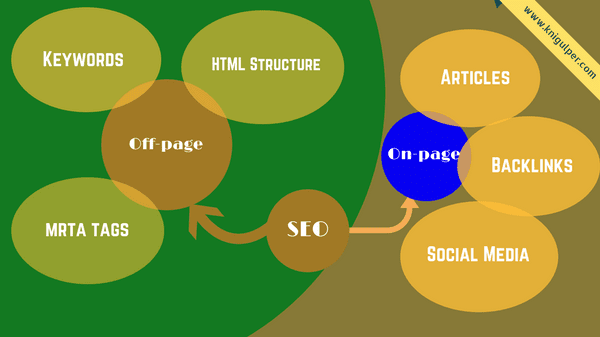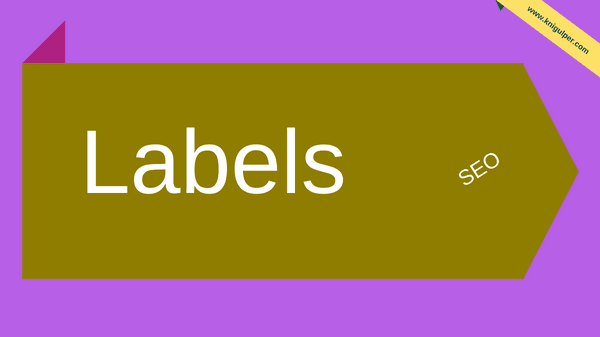6 Simple Steps To Optimize On-Page and Off-Page SEO
Onpage and Offpage SEO Techniques - Do you know what is the dream of a blogger and a website owner? Yes, it is making money with blogs. But one question that always confuses us is how to lure search engines to get our blogs appear on the top of search result pages. To win the search engines, we need to apply the SEO fundamentals on our blogs.

Check out: How To Get Your Blogs Appear In Featured Snippets
For our blogs to be successful, we need massive traffic and loyal visitors actively. Whether we sell products or offer services, we need mastery SEO tactics to optimize the websites so that it gets the maximum targeted traffic from the search engines but getting it right could be a difficult task. So how does it work?
In practical terms, we need two basic types of SEO these are on-page and off-page. On-page refers to the way we organize our web pages with regards to our keywords and keyword density. The terms we put in different web pages, and the names we give to our inbound links should be appropriate and under a certain limit. Off-page refers to our blog's relationship with the rest of the internet such as sharing on social media and looking for backlinks.
Firstly, we should optimize our contents thematically with relevant keywords that people are actually searching. We need to craft our contents around these keywords and phrases while keeping the text natural and interesting. In this regard, the contents of our sites are probably the most important factor for a successful SEO strategy.
Another essential thing to do is regularly update the website with fresh and original contents. The search engines reward sites that continually upgrade their blogs by giving them higher rankings. Plus, the inbound linking of our site can influence our SEO status. So make sure your links have meaningful and keyword-based anchor text. As for off-page optimization, we should work on steadily building up links.
Getting Your Site Optimized For Off-page and On-page
Optimizing a blog is an absolute thing to get the blogs from zero level to hero whether it should be on-page or off-page SEO. By optimizing a blog means to get as much as traffic through search engines and social media with the aim to boost both organic and direct traffic.
The philosophy of SEO is not a new thing but a bit confusing formula for beginners. In our daily blogging life, we see a lot of SEO analytics are continuously discussing the simple, as well as complex SEO techniques and yet our blogs, are getting no traffic. So, what is the reason behind this myth? The answer is on-page and off-page optimization issues.
1. Factors: How to Optimize On-page SEO
On-page optimization refers to all measures that can be taken around content keywords and HTML source code structure in order to improve its balance on the search engines. For that, I am going to show you simple yet easiest tips that you hopefully can understand.
Keyword Placement
The important thing that involves in on-page SEO is the keyword or a keyword-based phrase. Therefore, select the keywords that become the reference from the beginning since you created a blog. It is when you specify a blog topic.
For example, you want to create a job-based blog, then your primary keyword will be a job vacancy. For instance, if you create a blog for entertainment such as movies, then your reference will be the mp3 movies or mp4 movies.
Therefore, the first action in on-page SEO optimization that you need to take is to include your primary keyword(s) in your domain name and write it too in your title, description and throughout the contents.
Check out: How To Write Keyword Rich Articles
Optimizing HTML Structure
In the second step of optimization, complete your theme attributes such as title tag, meta description, sidebar area, and breadcrumb attribute, or any other element which is presented in your blog template. There are two different ways to get this job done. You can either optimize your current template or install a new one that has SEO friendly features.
2. Factors: How To Optimize Off-page SEO
Off-page optimization refers to all measures that can be taken outside of the website such as sharing to social media, looking for backlinks and much more. Therefore, you can apply the following steps to try it out.
Submit Your Site To Search Engines Google, Yahoo and Bing
This way is none other than submitting our Sitemap to Webmaster tools because by registering sitemap in webmaster tools will facilitate search engines to crawl your blog contents.
To submit your sitemap to Google, you need a Gmail account and a Microsoft account (yahoo mail or Hotmail) for Bing and Yahoo. You can submit your sitemap to Bing only because bing and yahoo are merged search engines alliances.
Share on Social Media
As another step for optimizing the off-page, social networking is the best choice whereby sharing content from our blogs that we manage in social networking will increase the ranking in the search engine.
Recommended: How to Easily Boost Your Traffic from Social Media
Looking For Backlinks
Optimizing off-page through backlinks is an additional point that is not less important to apply. Getting quality backlinks from the authoritative and relevant blogs will make our backlink profile strong. However, if we attempt to get the backlinks from those blogs that contain copy paste or low-quality text, our backlinks will be considered infectious and guess what will happen?
Quality Contents
The third tip that you can follow by publishing the more and more quality contents on your blog and it must be the motto of your blogging life.
A long time ago, I have published an article 6 SEO Secrets for Blogs in which I described how to write high-quality articles for your blogs.
Tips To Write Quality Contents
- An SEO friendly article contains at least 6 keywords or keyword terms that you want to target
- Include one primary and unique keyword in italic style
- Write one unique keyword in bold style
- Include 3-4 keywords in your first paragraph
- Write one phrase and include your primary keyword at the end of your post
- Write at least two-three keywords at the beginning of each paragraph and one-two words in H1, H2 and H3 tags. To learn more about heading tags, please refer to the article what are H1, H2, and H3 tags for more details
- In order to make your posts more SEO friendly, write the targeted keywords in your image ALT tag
- Create at least 3 internal links in your web pages
- Write an article that has enough text such as 500-2500 words long or more. Short articles are hard to rank and long articles that are difficult to understand is equal to short articles. You can use our online calculator to count the words. In addition to checking the number of words, you can also check the uniqueness of the articles by using the Grammarly tool
- The keywords in the post title and permalink should match to each other or contain the same keywords in both
Conclusion
On-page and Off-page SEO Optimization can be done easily with few tips and tweaks that I discussed in this article. On-page SEO can be enhanced by optimizing the template/theme structure while Off-page Optimization can be done gradually and it is a sharp weapon to make blogs look better on search engines like Google, Yahoo, and Bing.



Its amazing post about optimization on page and off page seo...thanks for sharing this article
ReplyDeleteThanks for your appreciation.
DeleteSir Table of contents aapne kaise add kiya?
ReplyDeleteWith jQuery
Delete